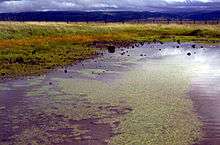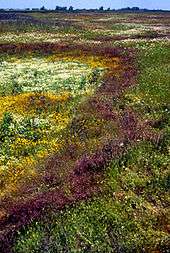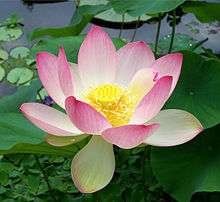Vernal pool

Vernal pools, also called vernal ponds or ephemeral pools, are seasonal pools of water that provide habitat for distinctive plants and animals. They are considered to be a distinctive type of wetland usually devoid of fish, and thus allow the safe development of natal amphibian and insect species unable to withstand competition or predation by fish. Certain tropical fish lineages (such as killifishes) have however adapted to this habitat specifically.
Generation and annual development
During most years, a vernal pool basin will experience inundation from local surface runoff, followed by desiccation from evapotranspiration. These conditions are commonly associated with Mediterranean climate. Most pools are dry for at least part of the year, and fill with the winter rains or snow melt. Some pools may remain at least partially filled with water over the course of a year or more, but all vernal pools dry up periodically. A key time during vernal pool development between the flooding and evaporation phases is the flowering of native species, which attracts pollinators and seed distribution patterns.
Some authorities restrict the definition of vernal pools to exclude seasonal wetlands that have defined inlet and outlet channels. The justification is that such seasonal wetlands tend to be qualitatively different from isolated vernal pools; this is because they are fed by larger drainage basins so that firstly, inflow contributes higher concentrations of dissolved minerals. Secondly, flow patterns increase the periodic scouring and silting effect of flows through or simply into the wetland. Thirdly, longer distance inflow and outflow make for less strictly endemic populations and plants. Low dissolved mineral concentrations of smaller vernal pool basins may be characterized as oligotrophic, and poorly buffered with rapid pH shifts due to carbon dioxide uptake during photosynthesis.[1]
Vernal pools are so called because they are often, though not necessarily, at their maximum depth in the spring ("vernal" meaning of, relating to, or occurring in the spring). There are many local names for such pools, depending upon the part of the world in which they occur. Vernal pools may form in forests, but they are more typically associated with grasslands and rocky plains or basins. While many vernal pools are only a few meters in width, playas and prairie potholes are usually much larger, but still are otherwise similar in many respects, with high water in wet periods, followed by dry conditions.[2] Some exclude desert playas from the definition of vernal pools because their larger closed drainage basins in areas with high evaporation rates produce higher concentrations of dissolved minerals, with salinity and alkalinity favoring different species. Playas may be inundated less frequently than vernal pools, and inundation typically coincides with colder weather unfavorable for plant growth.[3]
Ecology
Despite being dry at times, vernal pools teem with life when filled. The most obvious inhabitants are various species of breeding frogs and toads. Some salamanders also utilize vernal pools for reproduction, but the adults may visit the pool only briefly. Other notable inhabitants are Daphnia and fairy shrimp, the latter often used as an indicator species to decisively define a vernal pool. Other indicator species, at least in New England, are the wood frog, the spadefoot toad, and some species of mole salamanders. Certain plant species are also associated with vernal pools, although the particular species depend upon the ecological region. The flora of South African vernal pools, for example, are different from those of Californian vernal pools, and they have characteristic Anostraca, such as various Branchipodopsis species. In some northern areas, tadpole shrimp are more common.
Habitat loss
Vernal pools harbor a distinct assemblage of flora and fauna that, in some cases, aren't found anywhere else on the planet. Despite this fact, about 90% of vernal pool ecosystems in California have been destroyed. Disturbingly, much of this destruction has occurred in recent years, with about 13% of remaining vernal pools being lost in the short interval from 1995-2005.[4] The major threats to vernal pool habitats in the Central Valley are agriculture, urbanization, changes in hydrology, climate change, and improperly managed grazing by livestock.
Restoration
Vernal pools are prime habitats to be targeted for restoration work due to their value as hotpots of biodiversity as well as recent history of extensive destruction and degradation. However, there have been varying rates of success attributed to various restoration efforts. A number of hypotheses exists as to why:
Hypothesis 1: Constructed pools are too deep.
Hypothesis 2: Edges of constructed pools narrower than natural ones.
Hypothesis 3: Constructed pools have steeper slopes than natural ones.
Results: Research suggest that the last two details (Hypothesis 2 & 3) are crucial in determining the habitat value of man-made vernal pools. In general, most constructed pools were too steep and did not have wide enough edges.
Mitigation
There has been a fair amount of controversy surrounding the practice of mitigation, which is the destruction of protected or endangered species and habitats, such as vernal pools, on the condition that whatever entity (business, land manager, etc.) is destroying the habitat will undertake the construction of a replacement habitat to "mitigate" their impacts. This concept is difficult to apply to vernal pools, which represent a tremendous habitat value- but are difficult to successfully replicate using construction methods (as mentioned above). Thus, it has been very controversial to apply mitigation strategies to vernal pool systems due to the obvious risks inherent in trying to reconstruct this kind of habitat. Although, some agencies are now requiring two replacements for every vernal pool that is destroyed, in order to compensate for the low quality of man-made habitat.
Soils
Vernal pools can form anywhere that a depression fills with water. They can be found on bedrock of many kinds, or in grasslands that form over a variety of soil types containing silts and clays. They can develop hydric soils which are typical of flooded areas, including accumulations of organic matter, but this may not happen in drier areas. In some cases there is a hard pan layer which causes the retention of water in the pools.[5] The hardpan clay basin accumulates water due to the small particle size and therefore reduced porosity. This permits flooding and development of vernal pools.
Flora

In vernal pools, flowering occurs simultaneously because of the seasonality of favorable conditions. Vernal pool ecosystems may include both cosmopolitan species and endemic species adapted to unique environmental conditions. These include moisture gradients, salinity gradients, and reduced levels of competition.[2] Mircrotopographical gradients also contribute to species distribution in vernal pool communities, where plants that flower sooner in the season are more likely to be found at slightly higher elevations than later flowering species. Many vernal pool plants have buried seeds which accumulate in the soil. Different species are suited to different moisture levels, and as water evaporates from the edges of a pool, distinctive zonation of species can be seen.
Many upland perennial plants are unable to withstand the duration of vernal pool inundation; while many wetland plants are unable to withstand desiccation. Wetland plants may also be nutrient limited within small drainage basins. When dissolved carbon dioxide is depleted by daytime photosynthesis, vernal pool species like Howell's quillwort (Isoetes howellii) and pygmyweed (Crassula aquatica) collect carbon dioxide nocturnally using Crassulacean acid metabolism. Vernal pool basin habitats favor annual plants with some uniquely adapted perennials which suffer extensive mortality resembling annual reproduction. Annuals comprise approximately 80 percent of vernal pool flora. Listed below are some genera of the approximately one hundred vascular plant species associated with California vernal pool habitats; although a typical pool will include only 15 to 25 species.[6]
- Cosmopolitan aquatic flora
- quillworts (perennial)
- water clover (perennial)
- pillworts (perennial)
- water starworts
- succulents
- waterworts
- mousetail
- buttercups
- spikerushes (perennial)
- lilaea
- Vernal pool specialists
Upland plants commonly found at vernal pools in California include yellow pansies, several sweet-scented clovers, yellow and bright lavender monkeyflowers, star lilies, and yarrow.
Vernal pools are often threatened by development in the same way that other wetlands are. As a result, most pools have been converted into residential zones, roads, and industrial parks. That is why most extant pools occur on protected or private land such as national parks, and ranches.
A large number of rare, endangered species, and endemic species occur in vernal pool areas. For example, the San Diego mesa mint, a highly endangered plant, is found exclusively in vernal pools in the San Diego area. Another example is the wildflower Lasthenia conjugens, which is found in limited parts of the San Francisco Bay Area. A third example is the herb Limnanthes vinculans endemic to Sonoma County, California.
Fauna
(NRCS_Photo_Gallery).jpg)
Many of the amphibians that breed only in vernal pools spend most of their lives in the uplands within hundreds of feet of the vernal pool. Eggs are laid in the vernal pool, then the juveniles leave the pool two or three months later, not to return until the following spring to breed. Therefore, the upland areas surrounding a vernal pool are critical for the survival of these species. In New York state, the endangered tiger salamander (Ambystoma tigrinum) is dependent on vernal pools to breed as described above. A few other obligate vernal pool species are the marbled salamander (Ambystoma opacum), Jefferson's salamander (Ambystoma jeffersonianum), the blue-spotted salamander (Ambystoma laterale) and the spotted salamander (Ambystoma maculatum).
Some other species, notably Anostraca, fairy shrimp and their relatives, lay eggs capable of entering a state of cryptobiosis. They hatch when rains replenish the water of the pool, and no stage of the animals' life cycle leaves the pool, except when eggs are accidentally transported by animal phoresis, wind, or rarely, by flood. Such animal populations may be very old indeed, when the conditions for seasonal vernal waters are stable enough. As an extreme example, Branchipodopsis relictus on the main island of the Socotra archipelago, which is exceedingly remote for what it is, a continental fragment of Gondwana, is believed to have been isolated since the Miocene. Branchipodopsis relictus is correspondingly isolated genetically as well as geographically.[7]
See also
References
- ↑ Bauder, Ellen T.; Belk, Denton; Ferrer, Wayne T., Jr. (1998). Witham, Carol W., ed. Ecology, Conservation, and Management of Vernal Pool Ecosystems. California Native Plant Society. p. 1. ISBN 0-9434-6037-9.
- 1 2 Keddy, Paul A. (September 13, 2010). Wetland Ecology: Principles and Conservation (Second ed.). Cambridge University Press. pp. 48–52, 65. ISBN 0-5217-3967-5.
- ↑ Bauder, Ellen T.; Belk, Denton; Ferrer, Wayne T., Jr. (1998). Witham, Carol W., ed. Ecology, Conservation, and Management of Vernal Pool Ecosystems. California Native Plant Society. pp. 10–11. ISBN 0-9434-6037-9.
- ↑ "California's Vernal Pools". California Department of Fish and Wildlife. June 17, 2013. Archived from the original on February 22, 2018. Retrieved June 14, 2017.
- ↑ Hogan, C. Michael (July 31, 2010). Monosson, Emily, ed. "Abiotic factor". Encyclopedia of Earth. National Council for Science and the Environment. Archived from the original on June 8, 2013.
- ↑ Bauder, Ellen T.; Belk, Denton; Ferrer, Wayne T., Jr. (1998). Witham, Carol W., ed. Ecology, Conservation, and Management of Vernal Pool Ecosystems. California Native Plant Society. pp. 2–3, 5. ISBN 0-9434-6037-9.
- ↑ Van Damme, Kay; Dumont, Henri J.; Weekers, Peter H. H. (May 9, 2004). "Anostraca (Crustacea: Branchiopoda) from Socotra Island: A new Branchipodopsis and its relationship with its African and Asian congeners". Fauna of Arabia. 20: 193–209.
External links
| Wikimedia Commons has media related to Vernal pools. |
